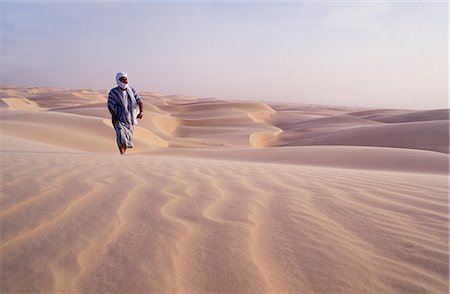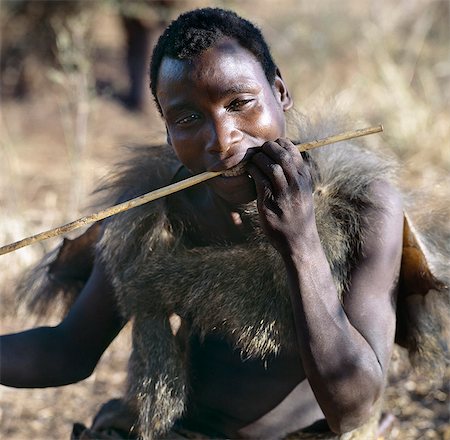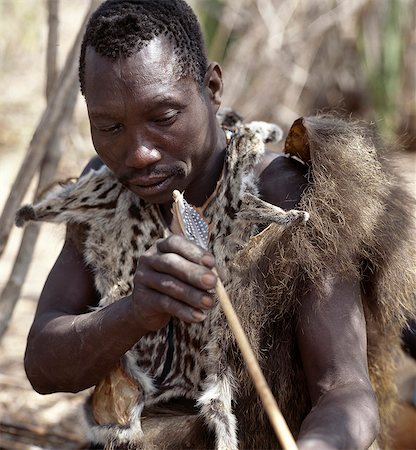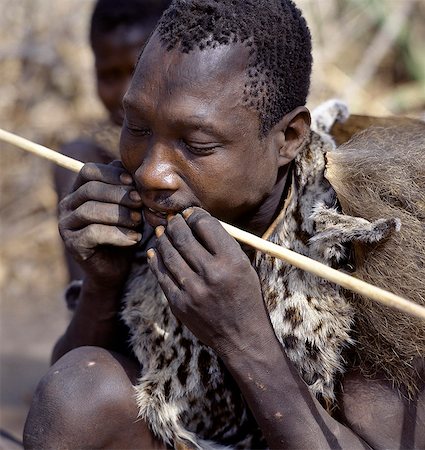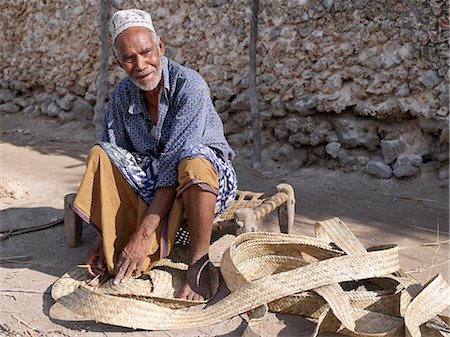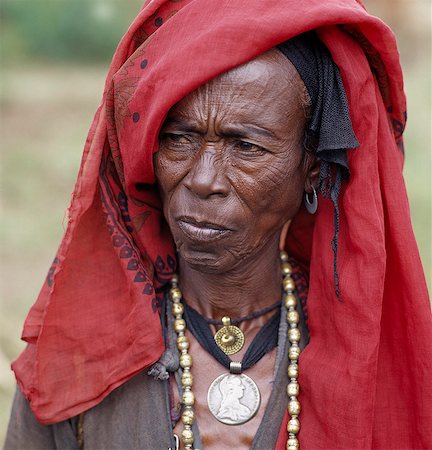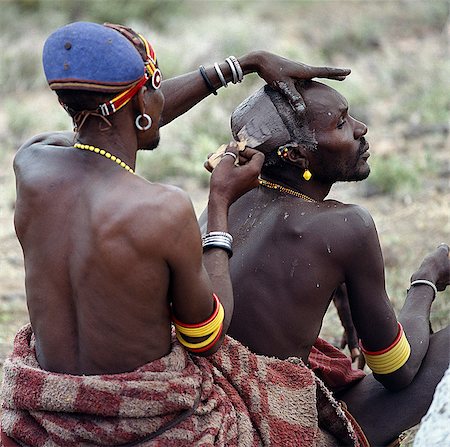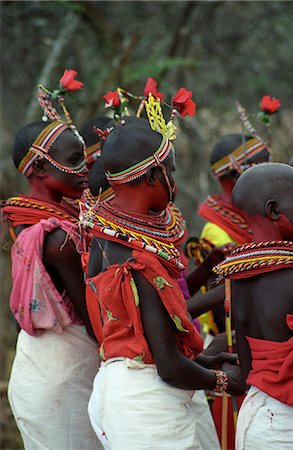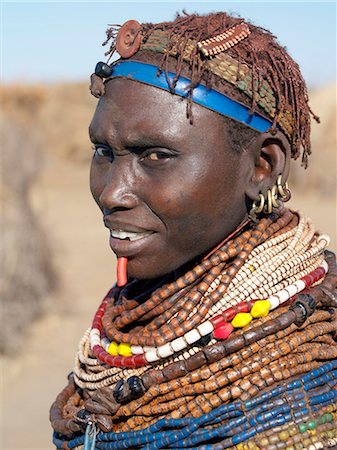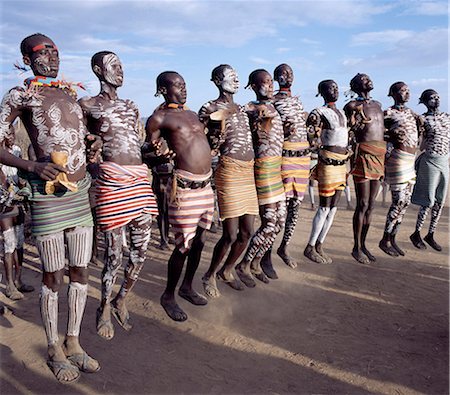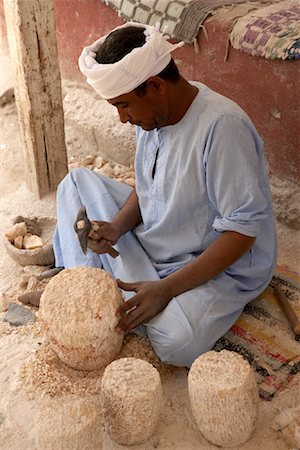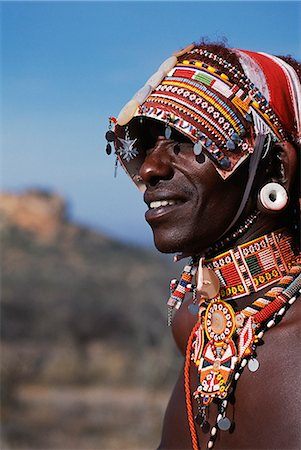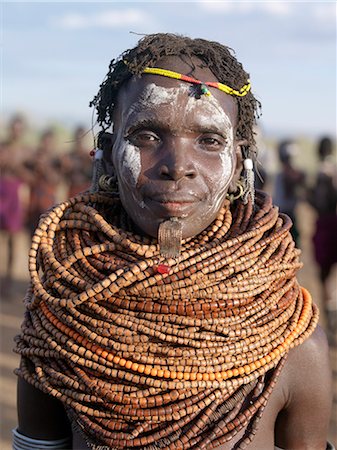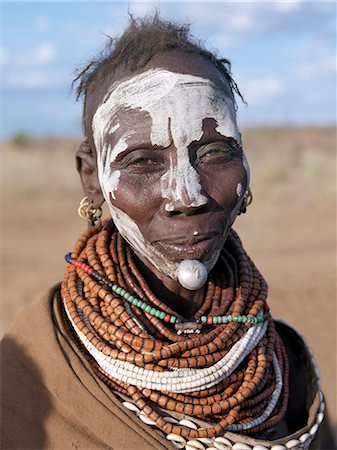-
The Librarian sits outside,infront of Mauritania's oldest library,and inspects some old manuscripts.
Con derechos protegidos
-
Meharistes',Soldiers Of The Desert,annual camel race. A Mehariste on his camel ready for the the start of the race.All the jockeys are in traditional costume especially for the occasion. Usually they would wear a uniform.
Con derechos protegidos
-
Mehariste,Soldier Of The Desert,in traditional costume. Usually they would wear a uniform.
Con derechos protegidos
-
Portrait of an old Mauritanian woman. The life expectancy of Mauritanians is about 53 years.Sondage is a new village named after the recent discovery of water there. The village was built by a Millionaire from Nouakchott. He has provided medical help and has organised a weekly market,for the nomads,which takes place on Fridays.
Con derechos protegidos
-
Meharistes',Soldiers Of The Desert,annual camel race. Meharistes mounted on their camels ready for the the start of the race. All the jockeys are in traditional costume especially for the occasion. Usually they would wear a uniform.
Con derechos protegidos
-
Meharistes,Soldiers Of The Desert,preparing for their annual camel race. All are in traditional costume especially for the occasion. Usually they would wear a uniform.
Con derechos protegidos
-
A nomad sits in the desert and talks on his mobile phone. It should be noted that it is not always possible to recieve a signal.
Con derechos protegidos
-
A nomad sits in the desert and talks on his mobile phone. It should be noted that it is not always possible to recieve a signal.
Con derechos protegidos
-
A Hadza hunter wearing a baboon skin cape straightens a new arrow shaft in his teeth.The Hadzabe are a thousand-strong community of hunter-gatherers who have lived in the Lake Eyasi basin for centuries. They are one of only four or five societies in the world that still earn a living primarily from wild resources.
Con derechos protegidos
-
A Hadza hunter wearing the skins of a baboon and genet cat checks the straightness of a new arrow shaft,fledged with guinea fowl feathers.The Hadzabe are a thousand-strong community of hunter-gatherers who have lived in the Lake Eyasi basin for centuries. They are one of only four or five societies in the world that still earn a living primarily from wild resources.
Con derechos protegidos
-
A Hadza hunter wearing as genet cat skin cape straightens a new arrow shaft in his teeth. The Hadzabe are a thousand-strong community of hunter-gatherers who have lived in the Lake Eyasi basin for centuries. They are one of only four or five societies in the world that still earn a living primarily from wild resources. .
Con derechos protegidos
-
A Mauritanian man sits cross legged and makes tea in the traditonal way. He is sitting outside some rooms that are rented out to tourists.Tea is traditional drunk from a small glass and is served hot,black,sweet and strong.
Con derechos protegidos
-
A Nyangatom girl weaves a grass basket. The Nyangatom or Bume are a Nilotic tribe of semi-nomadic pastoralists who live along the banks of the Omo River in south-western Ethiopia.
Con derechos protegidos
-
A Hadza hunter wearing a baboon skin returns to camp with a haunch of impala over his shoulder. He killed the antelope with a metal tipped arrow that had been dipped in a fast acting vegetable poison extracted from the desert rose.
Con derechos protegidos
-
Turkana elders wear decorative ivory lip ornaments,secured in position by a spigot which is inserted in a hole pierced below the man's lower lip after initiation. This singular form of decoration was once widespread but is rarely seen today.
Con derechos protegidos
-
A Samburu blacksmith fashions a spear from an iron rod. Blacksmiths have their own special clan within the tribe and are not allowed to marry girls from other clans. Their skills are handed down from father to son. This man will take two days to make a spear for which he will be paid a goat.
Con derechos protegidos
-
A skilled craftsman puts the finishes touches to a replica of a Pate Island chair. Wood carving is the most important craft in Lamu and sustains the greatest number of artisans. Fine marquetry work is another age old skill of local craftsmen.Situated 150 miles north northeast of Mombasa, Lamu town dates from the 15th century AD.
Con derechos protegidos
-
A Samburu woman sews a leather cloak for her younger brother. For several weeks before a boy is circumcised,he must wear a charcoal-blackened cloak,which is made from three goatskins.
Con derechos protegidos
-
A Dassanech woman winnows grain by pouring it from her metal tin and letting it fall onto a calfskin. Much the largest of the tribes in the Omo Valley numbering around 50,000,the Dassanech (also known as the Galeb,Changila or Merille) and Nilotic pastoralists and agriculturalists.
Con derechos protegidos
-
An elder of the Karo tribe,a small Omotic tribe related to the Hamar,who live along the banks of the Omo River in southwestern Ethiopia. The Karo are renowned for their elaborate body painting using white chalk,crushed rock and other natural pigments. This man also has a clay hairdo typical of tribal elders. Like most adult males he carries a rifle.
Con derechos protegidos
-
A Swahili woman in Lamu makes makuti, a coconut palm thatch used extensively as a roofing material on houses all along the East African Coast.Situated 150 miles north northeast of Mombasa, Lamu town dates from the 15th century AD.
Con derechos protegidos
-
A skilled craftsman puts the finishes touches to a replica of a Pate Island chair. Wood carving is the most important craft in Lamu and sustains the greatest number of artisans. Fine marquetry work is another age old skill of local craftsmen.Situated 150 miles north northeast of Mombasa, Lamu town dates from the 15th century AD.
Con derechos protegidos
-
Seated on a typical coast stool, a Swahili man stitches strips of woven palm fronds into a mat in one of Pates narrow streets.All the buildings in Pate are constructed of coral rag with makuti roofs, which are a type of thatch made from coconut palm fronds.
Con derechos protegidos
-
A woman makes makuti, a thatch from dried fronds of coconut palms, outside her home in Faza village. The chequered history of Faza dates back several hundred years.
Con derechos protegidos
-
An old Oromo woman wears a brass necklace and pendant, and a silver pendant made from a Maria Theresa thaler, an old silver coin minted in Austria, which was widely used as currency in northern Ethiopia and Arabia until the end of World War II. With a bright red headscarf, She was on her way to Senbete, an important weekly market close to the western scarp of the Abyssinian Rift.
Con derechos protegidos
-
Shaded from the hot sun, a Karo woman grinds sorghum using large flat stones.It is customary for females of the tribe when in their teens to make a small hole in the flesh below their lower lips into which they put an ornament, this woman has used a small nail. Numerous heavy metal bracelets are worn by married womenThe Karo are a small tribe living in three main villages along the lower reaches o
Con derechos protegidos
-
A man stitches together woven strips of palm fronds to make a large floor mat at Matondoni,Lamu Island. The place has been famous for making traditional wooden sailing boats for a century or more.
Con derechos protegidos
-
Up to a year before his circumcision,a Samburu boy will style his hair in a distinctive 'pudding bowl' shape and often rub charcoal and fat into it.Uncircumcised boys are considered children whatever their age. They have no standing in the tribe and do not belong to an age-set.
Con derechos protegidos
-
An expert hairstylist smears clay on the crown of a man's head,then fashions it into an elliptical bun before colouring it with natural pigments. The elliptical clay bun,so characteristic of the Turkana,is now dying out.
Con derechos protegidos
-
Black ostrich feathers decorate the front part of this Turkana man's traditional clay hairdo. Small metal chains,with or without beads attached to the ends of them,are commonplace ear ornaments.
Con derechos protegidos
-
Turkana elders wear decorative ivory lip ornaments,secured in position by a spigot which is inserted in a hole pierced below the man's lower lip after initiation. This singular form of decoration was once widespread but is rarely seen today. Likewise,the traditional clay hairdo is gradually dying out.
Con derechos protegidos
-
Berber tribesman in the sand dunes of the Erg Chegaga,in the Sahara region of Morocco.
Con derechos protegidos
-
A young Amhara lady weaves a traditional food basket from dried grasses. These large colourful baskets are used for serving injera,a fermented,bread-type pancake,which is the country's national dish.She is wearing the national dress of Ethiopia - a shamma. This garment is made of homespun cotton with a finely woven and often brightly coloured border.
Con derechos protegidos
-
A warrior of the Kisongo section of the Maasai with his long Ochred braids decorated with beaded ornaments. His broad armulet is typical of the Kisongo living in northern Tanzania where white is the preferred colour of their beadwork.
Con derechos protegidos
-
A Dassanech girl braids her sister's hair at her village in the Omo Delta. Much the largest of the tribes in the Omo Valley numbering around 50,000,the Dassanech (also known as the Galeb,Changila or Merille) and Nilotic pastoralists and agriculturalists.
Con derechos protegidos
-
A Lamu man strings the back of a traditional Lamu style chair embellished with marquetry.Situated 150 miles north northeast of Mombasa, Lamu town dates from the 15th century AD. The islands importance lies in the fact that it has the only certain source of sweet groundwater in the entire district.
Con derechos protegidos
-
A Turkana man sports a fine array of ostrich feathers from his clay hairdo.Having discarded the discomfort of an ivory lip ornament, he has to insert a small wooden plug in the hole beneath his lower lip to prevent dribbling. He wears the traditional Turkana wrist knife on his right wrist.
Con derechos protegidos
-
A Nyangatom woman wears numerous strands of beads made from wood.The Nyangatom are one of the largest tribes and arguably the most warlike people living along the Omo River in Southwest Ethiopia. They form a part of the Ateger speaking people a cluster of seven eastern Nilotic tribes to which the Turkana of Northern Kenya and the Karamajong of Eastern Uganda belong.
Con derechos protegidos
-
An attractive Oromo girl in the medieval walled city of Harar. Her beaded jewellery sets her apart from Harari residents.Once an independent city state dating back to the early 16th century, Harar was incorporated into the Ethiopian Empire in 1887.
Con derechos protegidos
-
Ethiopia, Harerge Province, Harar.An Harari girl in wedding attire.Unlike Muslims elsewhere, Harari women love bright clothes and are seen in public without face veils.The beautifully embroidered silk dress can be turned inside out, where it is black, and worn at funerals.
Con derechos protegidos
-
An Oromo old woman wears a necklace and a pendant made from a Maria Theresa thaler, an old silver coin minted in Austria, which was widely used as currency in northern Ethiopia and Arabia until the end of World War II. She was on her way to Senbete, an important weekly market close to the western scarp of the Abyssinian Rift.Afar nomads from the low lying arid regions of Eastern Ethiopia trek long
Con derechos protegidos
-
Karo men excel in body art. Before a dance, they will decorate their faces and torsos elaborately using local white chalk, pulverised rock and other natural pigments. While older men style their hair with clay, young men prefer to braid theirs.Every man carries a wooden stool, which doubles as a pillow at night.The Karo are a small tribe living in three main villages along the lower reaches of the
Con derechos protegidos
-
Karo men excel in body art. Before a dance, they will decorate their faces and torsos elaborately using local white chalk, pulverised rock and other natural pigments. While older men style their hair with clay, young men prefer to braid theirs.Every man carries a wooden stool, which doubles as a pillow at night.The Karo are a small tribe living in three main villages along the lower reaches of the
Con derechos protegidos
-
Karo men excel in body art. Before a dance, they will decorate their faces and torsos elaborately using local white chalk, pulverised rock and other natural pigments. While older men style their hair with clay, young men prefer to braid theirs.Every man carries a wooden stool, which doubles as a pillow at night.The Karo are a small tribe living in three main villages along the lower reaches of the
Con derechos protegidos
-
A Dassanech elder wearing a traditional clay hairdo, topped with ostrich feathers. His broad beaded necklace is unusual for its size but his five brass earrings are a common decoration of both men and women.The Dassanech people live in the Omo Delta of southwest Ethiopia, one of the largest inland deltas in the world.
Con derechos protegidos
-
An old Dassanech man wearing a traditional metal lip ornament and metal earrings. His broad ivory armbands and his ivory tobacco container hanging round his neck, are uncommon because elephants no longer frequent the Omo Delta.The Dassanech people live in the Omo Delta of southwest Ethiopia, one of the largest inland deltas in the world.
Con derechos protegidos
-
A Dassanech man stands on one leg in typical pose while looking after his familys cattle in the Omo Delta, one of the largest inland deltas in the world. The extensive scarification on his chest and shoulders denotes that he has killed an enemy.They practice animal husbandry and fishing as well as agriculture.
Con derechos protegidos
-
A Dassanech man stands on one leg in typical pose while looking after his familys cattle in the Omo Delta, one of the largest inland deltas in the world. The extensive scarification on his chest and shoulders denotes that he has killed an enemy.They practice animal husbandry and fishing as well as agriculture.
Con derechos protegidos
-
Woman in Traditional Clothing Sewing, Vosloorus, Gauteng, South Africa
Con derechos protegidos
-
A Samburu warrior drinks blood straight from the fold of skin cut in a goat's neck.During every Samburu ceremony,livestock is slaughtered and meat is roasted over wood fires. Warriors will never eat meat in the presence of married women.
Con derechos protegidos
-
Gabbra women dance at a gathering in the village of Kalacha. The Gabbra are a Cushitic tribe of nomadic pastoralists living with their herds of camels and goats around the fringe of the Chalbi Desert.
Con derechos protegidos
-
Gabbra women dance at a gathering in the village of Kalacha. The Gabbra are a Cushitic tribe of nomadic pastoralists living with their herds of camels and goats around the fringe of the Chalbi Desert.
Con derechos protegidos
-
Gabbra women sing and dance to celebrate a wedding. The traditional metal ornamentation on their heads is called malmal.
Con derechos protegidos
-
Two Turkana men in traditional attire relax in the heat of the day under a shady tree. Every man will have a wooden stool,which doubles up as a pillow at night to protect his clay hairdo. Men will never sit on the ground; only women and children are permitted to do so.
Con derechos protegidos
-
A young Samburu man leads a donkey carrying the basic structure of a temporary home. The curved sticks will be tied together in a dome and covered with hides and woven mats to form a temporary shelter in a stock camp. Donkeys are widely used by the Samburu as beasts of burden.
Con derechos protegidos
-
A Samburu moran teaches children the skills of being a warrior during a Cheli & Peacock family mobile safari.
Con derechos protegidos
-
Samburu moran (warrior) tries the feel of a shotgun at the end of a bird shooting safari.
Con derechos protegidos
-
A Hadza girl wearing a beaded headband and necklaces.The Hadzabe are a thousand-strong community of hunter-gatherers who have lived in the Lake Eyasi basin for centuries. They are one of only four or five societies in the world that still earn a living primarily from wild resources.
Con derechos protegidos
-
Maasai girls gather to celebrate a wedding. Their broad beaded necklaces with predominantly white glass beads mark then as Kisongo Maasai,the largest clan group of the tribe which lives either side of the Kenya-Tanzania border.
Con derechos protegidos
-
A Maasai girl in traditional attire. The predominant white colour of her beadwork and the circular scar on her cheek denote that she is from the Kisongo section of the Maasai,the largest clan group,which lives either side of the border in Kenya and Tanzania.
Con derechos protegidos
-
A Maasai warrior with his hair styled in a most unusual way. His long braids have been wrapped tightly in leather,decorated with beads and tied in an arch over his head. A colobus monkey tail sets this singular hairstyle apart from the more traditional warrior styles.
Con derechos protegidos
-
Berber tribesmen in the sand dunes of the Erg Chegaga,in the Sahara region of Morocco.
Con derechos protegidos
-
Berber tribesmen in the sand dunes of the Erg Chegaga,in the Sahara region of Morocco.
Con derechos protegidos
-
An elder of the Karo tribe sits with his wife and child. A small Omotic tribe related to the Hamar,who live along the banks of the Omo River in southwestern Ethiopia,the Karo are renowned for their elaborate body painting using white chalk,crushed rock and other natural pigments. This man also has a clay hairdo typical of tribal elders. Like most adult males he carries a rifle.
Con derechos protegidos
-
A Nyangatom woman grinds sorghum using two stones. Typical of her tribe,she wears a heavily beaded calfskin skirt,multiple layers of bead necklaces and metal bracelets and amulets. The Nyangatom or Bume are a Nilotic tribe of semi-nomadic pastoralists who live along the banks of the Omo River in south-western Ethiopia.
Con derechos protegidos
-
A Nyangatom girl churns butter in a gourd suspended in the entrance to her hut. Typical of her tribe,she is wearing multiple layers of beads in necklaces,and an elaborately beaded calfskin skirt. The Nyangatom or Bume are a Nilotic tribe of semi-nomadic pastoralists who live along the banks of the Omo River in south-western Ethiopia.
Con derechos protegidos
-
A Borana man at Mega in southern Ethiopia wears a phallic Kallaacha on his forehead. Made of cast aluminium and ivory or bone,the Kallaacha is worn during the tribe's initiation and gada age-grade ceremonies. The pastoral Borana live either side of the southern Ethiopian/northern Kenya border and form a large and important group of the Oromo-speaking cluster of tribes.
Con derechos protegidos
-
An Afar woman adjusts the load on her camel as her young child sits on top. Proud and fiercely independent,the nomadic Afar people live in the low-lying deserts of Eastern Ethiopia. Camels are valuable in these harsh conditions; they carry house structures and personal possessions,enabling families to follow the seasonal pattern of rain and grazing.
Con derechos protegidos
-
Elaborate headdress and body adornments worn by Samburu moran (warrior).
Con derechos protegidos
-
A smart young Hamar youth at Turmi Market.The Hamar are semi-nomadic pastoralists who live in harsh country around the Hamar Mountains of Southwest Ethiopia. Their whole way of life is based on the needs of their livestock. Cattle are economically and culturally their most important asset.
Con derechos protegidos
-
Two Hamar girl in fashionable dress at Turmi market. The Hamar are semi-nomadic pastoralists of Southwest Ethiopia whose women and girls wear striking traditional dress. Skins are widely used for clothing and heavy metal necklaces,bracelets and anklets form part of their adornments. Cowries are also popular yet the sea is 500 miles from Hamar country.
Con derechos protegidos
-
A Datoga woman in traditional attire, which includes beautifully tanned and decorated leather dresses and coiled brass necklaces and ear ornaments.Extensive scarification of the face with raised circular patterns is not uncommon among women and girls.
Con derechos protegidos
-
Samburu girls are given strings of beads by their fathers when they are still young. As soon as they are old enough to have lovers from the warrior age set, they regularly receive gifts from them.Over a period of years, their necklaces can smother them up to their necks.
Con derechos protegidos
-
A Nyangatom mother and young daughter in typical dress. Rugged skin clothing is still widely used.The Nyangatom are one of the largest tribes and arguably the most warlike people living along the Omo River in Southwest Ethiopia.
Con derechos protegidos
-
A Nyangatom woman wears numerous strands of beads made from wood.The Nyangatom are one of the largest tribes and arguably the most warlike people living along the Omo River in Southwest Ethiopia. They form a part of the Ateger speaking people a cluster of seven eastern Nilotic tribes to which the Turkana of Northern Kenya and the Karamajong of Eastern Uganda belong.
Con derechos protegidos
-
A Nyangatom woman wears numerous strands of beads made from wood.The Nyangatom are one of the largest tribes and arguably the most warlike people living along the Omo River in Southwest Ethiopia. They form a part of the Ateger speaking people a cluster of seven eastern Nilotic tribes to which the Turkana of Northern Kenya and the Karamajong of Eastern Uganda belong.
Con derechos protegidos
-
A Nyangatom woman wears numerous strands of beads made from wood.The Nyangatom are one of the largest tribes and arguably the most warlike people living along the Omo River in Southwest Ethiopia. They form a part of the Ateger speaking people a cluster of seven eastern Nilotic tribes to which the Turkana of Northern Kenya and the Karamajong of Eastern Uganda belong.
Con derechos protegidos
-
A Nyangatom woman wears numerous strands of beads made from wood.The Nyangatom are one of the largest tribes and arguably the most warlike people living along the Omo River in Southwest Ethiopia. They form a part of the Ateger speaking people a cluster of seven eastern Nilotic tribes to which the Turkana of Northern Kenya and the Karamajong of Eastern Uganda belong.
Con derechos protegidos









